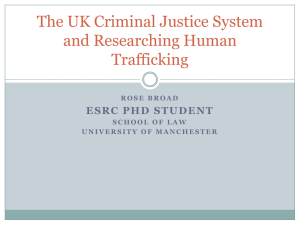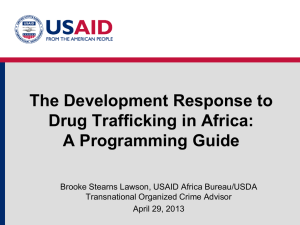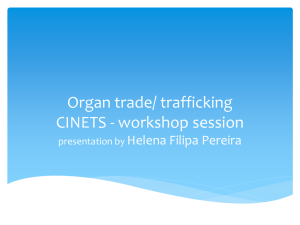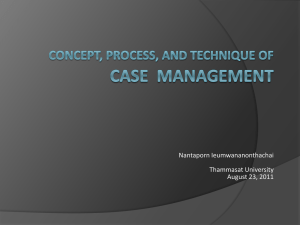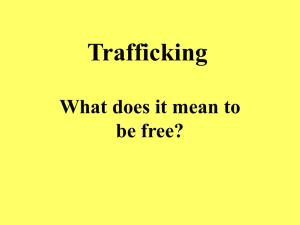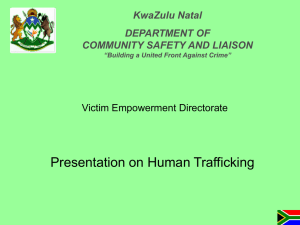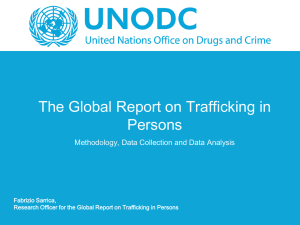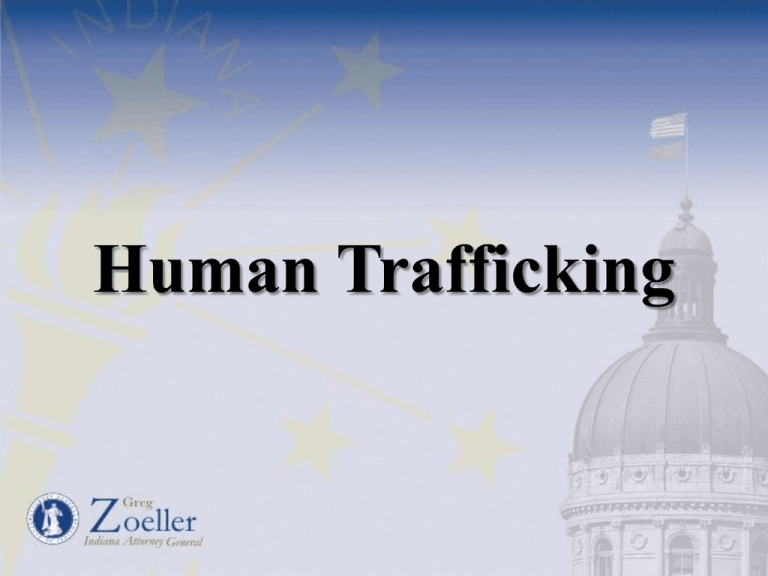
Human Trafficking
The Indiana Human
Trafficking Initiative
Department of Justice Task Force
2005 to Present
Task Force Partnering Agencies & Organizations:
U.S. Attorney’s Office, Indiana Attorney General’s Office, FBI, Indianapolis
Metropolitan Police Department, Attorney General, Marion County
Prosecutor's Office, Homeland Security, Department of Labor, Department of
Child Services, The Julian Center, Exodus Refugee Center, Neighborhood
Christian Legal Clinic, Crime Control Research, Kramer & Co.
IPATH
Indiana Protection for Abused and Trafficked Humans Task Force
PREVENTION, PROTECTION, PROSECUTION
The Indiana Protection for Abused Trafficked Humans task force (IPATH)
is one of 42 task forces nationwide funded by the Department of Justice’s
Office of Victims of Crime and the Bureau of Justice Assistance to address
the issue of human trafficking.
The Goals of IPATH are to:
1) Enhance law enforcement’s ability to identify and rescue victims.
2) Provide resources and training to identify and rescue victims.
3) Ensure comprehensive services are available for victims of trafficking.
A COLLABORATIVE
CLIENT CENTERED APPROACH
LAW
ENFORCEMENT
VICTIM
SERVICES
Collaborates with agencies on
current/future investigations,
provides officer trainings, &
prevention tactics
Works with identified victims
Providing legal & social services
AWARENESS
Community organizations
partnering together to
provide outreach and
education to the
community on human
trafficking
IPATH
TRAINING
Provides trainings to
organizations that
might come into
contact with victims.
PROTOCOL
Creating and evaluating protocol
or the task force & the procedure
for handling human trafficking
situations
What is Human Trafficking?
Sex Trafficking: in which a commercial sex act is induced by force, fraud,
or coercion, or in which the person induced to perform such act has not
attained 18 years of age; or
Labor Trafficking: The recruitment, harboring, transportation, provision,
or obtaining of a person for labor or services, through the use of force, fraud,
or coercion for the purpose of subjection to involuntary servitude, peonage,
debt bondage, or slavery. (1)
1)
Victims of Trafficking and Violence Protection Act of 2000, Pub. L. No. 106-386 (2000), available at
http://www.state.gov/documents/organization/10492.pdf.
Distinguishing Trafficking
from other Crimes
• Human Trafficking vs. Smuggling
– Smuggling is illegal transportation of a person across international borders.
– Smuggling is typically voluntary and the person is free to leave afterwards.
– A trafficked person may be transported into a country, but the person is then
exploited for financial gain through labor services.
• Human Trafficking vs. Extortion
– Extortion is the collection of money through force or coercion (Sometimes
from family member after smuggling for a person’s freedom)
– Human Trafficking involves using the victim for labor or sexual services that
result in financial gain. The victim works to pay off the trafficker.
Distinguishing Trafficking
from other Crimes
• Human Trafficking vs. Sexual Assault
– Human Trafficking based on commercial sex requires that the person
has been forced to provide sexual services for profit. If other HT
factors are present, sexual assault can be a type of forced labor.
• Human Trafficking vs. Prostitution
– Human Trafficking requires that the person has been forced to
prostitute through force, fraud or coercion. The profit is often taken by
the trafficker.
• Human Trafficking vs. Labor Violations
– Labor Trafficking differs from other labor violations in that the victim
is forced to remain in the job and that they were “obtained” for the
purpose of economic exploitation.
Sex Trafficking Examples
Example #1:
A 17 year old girl* runs away from
her abusive family for the second
time. She meets a 20-something
man at the mall who befriends her
and offers to buy her something
pretty. Their romantic relationship
grows slowly as she becomes more
dependent upon him and believes
he loves her. He starts to ask her to
do things for him, eventually
leading to pimping her out for
profit and resorting to violence and
psychological trauma to control
her.
Example # 2:
Two sisters from Central America
receive help from a family friend to
migrate to the United States in order to
live with their cousins and go to school.
However after crossing the border, the
coyotes sell them to traffickers who
force them to strip, dance and provide
sexual services to pay off the
exaggerated debt for their
“transportation costs”. They are only
allowed to call family under the
supervision of the traffickers, are only
given $20 a week, and are frequently
threatened and abused.
*Stories are fictional and meant to be used for instructional use only.
While they include common elements of human trafficking, these
narratives are not taken from any one trafficking survivor.
Labor Trafficking Examples
Example # 1:
After losing his factory job*, a 35-year
old man answers a job advertisement
in the local newspaper for skilled
welders. The ad promises affordable,
safe housing and good pay. However,
after being coerced into signing a
“contract” in English, which he does
not speak, he is taken to his home: a 2bedroom apartment housing 8 other
men, costing him $600 per month. The
men are transported to a restaurant
where they work 15 hours a day and
their living costs always outnumber
their pay, causing them to become
burdened by an ever increasing debt.
Example # 2:
A 40-year old woman is told by a family
friend that he knows of a business man
looking to hire a secretary. There are two
housing options, live in the basement
apartment and earn more money, or live
outside for less money. Once she begins the
work, she realizes he has different
expectations for his “personal assistant.” He
makes her clean cook, working 12 hours a
day. He is always telling her how to do
things and criticizing her. She sleeps under
the stairs rather than in a room. She is never
paid, but for a while she is hopeful that he
will fulfill his promise. When she says she
wants to leave, he resorts to violence and
threatens to kill her.
*Stories are fictional and meant to be used for instructional use
only. While they include common elements of human trafficking,
these narratives are not taken from any one trafficking survivor.
A Growing Problem Worldwide
Human Trafficking is tied as the SECOND LARGEST and FASTEST growing criminal
industry in the world, just behind the drug trade. (1)
According to the U.S. Dept. of State’s
2013 Trafficking in Persons Report(TIP),
27 million people are estimated to be
victims of human trafficking worldwide.
In 2012, only 40,000 of those were
identified. (2)
Every year 1 million children are exploited by the
commercial sex trade. (4)
The 2010 TIP Report stated that: (3)
161 countries identified as being affected by human
trafficking. (5)
– 800,000 people are trafficked
across international borders every
year.
– Prevalence of trafficking victims
worldwide: 1.8 per 1,000
inhabitants
1)
2)
3)
4)
5)
6)
$32 billion dollars generated annually by the human
trafficking industry. (6)
Administration for Children & Families, U.S. DEPT. OF HEALTH & HUMAN SERVICES, http://www.acf.hhs.gov/trafficking/about/index.html (last visited Jan. 13, 2012).
U.S. Dept. of State Trafficking in Persons Report (2013), available at http://www.state.gov/j/tip/rls/tiprpt/2013/index.htm.
U.S. Dept. of State Trafficking in Persons Report (2010), available at http://www.state.gov/g/tip/rls/tiprpt/2010/index.htm.
U.S. DEPARTMENT OF STATE, THE FACTS ABOUT CHILD SEX TOURISM (2005) at p.22 (2005), available at http://www.state.gov/documents/organization/47255.pdf.
UN OFFICE OF DRUGS AND CRIME, TIP REPORT: GLOBAL PATTERNS (2006) at p.58, available at http://www.unodc.org/pdf/traffickinginpersons_report_2006ver2.pdf.
INTERNATIONAL LABOR ORGANIZATION (ILO), A GLOBAL ALLIANCE AGAINST FORCED LABOR (2005) at p.55, available at
http://www.ilo.org/wcmsp5/groups/public/@ed_norm/@declaration/documents/publication/wcms_081882.pdf.
A Growing Problem Here at Home
Between 14,500 and 17,500 men, women, and children are trafficked into the United States
each year. (1)
Nearly 300,000 American youths are at risk of becoming victims of commercial sexual
exploitation, according to the FBI. (2)
12-14 is the average age of entry into commercial sex in the U.S. (3)
33% of a sample group of female commercial sex workers in Chicago began in the sex trade
between the ages of 12 and 15, with 56% being 16 or younger. (4)
83% of sex trafficking victims found in the U.S. were U.S. citizens, according to one Justice
Department study (5)
1)
2)
3)
4)
5)
U.S. DEPT. OF STATE TRAFFICKING IN PERSONS REPORT (2010), available at http://www.state.gov/g/tip/rls/tiprpt/2010/index.htm; see also CONGRESSIONAL RESEARCH SERVICE, TRAFFICKING IN
PERSONS: U.S. POLICY AND ISSUES FOR CONGRESS (2010) at p.2, available at http://www.unhcr.org/refworld/topic,4565c22535,4565c25f42b,4d2d96e62,0,USCRS,,.html.
Amanda Walker-Rodriguez & Rodney Hill, Human Sex Trafficking, FED. BUREAU INVESTIGATION (Mar. 2011), http://www.fbi.gov/statsservices/publications/lawenforcementbulletin/march_2011/human_sex_trafficking
Some research indicates that the average age of entry for U.S. girls is 12 to 14, while the average age for U.S. boys and transgender youth is 11 to 13. See Amanda Walker-Rodriguez and Rodney Hill,
Human Sex Trafficking, FBI LAW ENFORCEMENT BULLETIN, (March, 2011), available at http://www.fbi.gov/stats-services/publications/law-enforcement-bulletin/march_2011/human_sex_trafficking.
See also POLARIS PROJECT, CHILD SEX TRAFFICKING AT-A-GLANCE, (2011), available at http://loveandlighttofreedom.org/uploads/Child_Sex_Trafficking__Polaris_Project-_Jan_2012_.pdf. See also
Ernie Allen, President and CEO of the National Center for Missing and Exploited Children, speaking to the House Victims’ Rights Caucus Human Trafficking Caucus, Cong. Rec., 111th Cong., 2nd
sess., 2010. See also U.S. Children are Victims of Sex Trafficking (April 2008), HUMANTRAFFICKING.ORG, http://www.humantrafficking.org/updates/801.
SCHILLER DUCANTO & FLECK FAMILY LAW CENTER, DOMESTIC SEX TRAFFICKING OF CHICAGO WOMEN AND GIRLS (2008), available at
http://www.law.depaul.edu/centers_institutes/family_law/pdf/sex_trafficking.pdf.
This statistic is based on one study of confirmed sex trafficking incidents opened by federally funded U.S. task forces. Human Trafficking/Trafficking In Persons, Dept. of Justice, Bureau of Justice
Statistics, http://bjs.ojp.usdoj.gov/index.cfm?ty=tp&tid=40 (last visited 1/14/2012).
Midwest/Indiana Statistics
Investigations in US
BJA Funded Anti5,143 (2007-2012)
Trafficking Task Forces
Investigations in
Midwest
392 (2007-2012)
(1)
Investigations in
Indiana (2006-2013)
112 (law enforcement)
96 (service providers
funded through OVC)
US Statistics- Fiscal Year 2012
(2)
26 DOJ-led taskforces
Number of Investigations in the US
over 753
ICE-HSI
894
FBI
306 pending (adults and foreign child victims)
440 (sex trafficking of children)
1) Information was obtained from the Bureau of Justice Assistance (BJA). The BJA Task Forces in the Midwestern Region were located in the states of: Illinois,
Indiana, Missouri, Wisconsin, and Minnesota.
2) U.S. Dept. of State Trafficking in Persons Report (2013), available at http://www.state.gov/j/tip/rls/tiprpt/2013/index.htm.
Midwest/Indiana Statistics
Gender of Trafficking Victims:
70% Female
30% Male
Nationalities of Trafficking Victims:
40% Domestic
60% Foreign
Age of Trafficking Victim:
40% Adults
20% Minors
40% Unknown
Most Common Countries of Origin for
Foreign Victims:
1)Mexico
2)China
3)India
4)Russia
Types of Reported Trafficking Cases:
60% Sex
40% Labor
*Data was collected from both law enforcement agencies and service providers
throughout the Midwest. Individual results were averaged together to project average
stats in the area.
Data contributed by: ICE, FBI, HTRS, TIMS, & Polaris
Human Trafficking & Sporting Events
Studies have shown that there is an increase in the demand for commercial sex
services surrounding large sporting events or conventions such as the Super
Bowl, World Series, etc.
Any increase in the commercial sex industry also increases the potential risk for
exploitation and human trafficking.
A study conducted by KLAAS KIDS Foundation and F.R.E.E. International, in
conjunction with law enforcement, during the 2012 Super Bowl, found that online
escort ads were monitored weekly to show increase of activity:
– Thursday, January 12th: 17 (1)
– Thursday, January 19th: 18 (1)
– Thursday, January 26th: 28 (1)
– Thursday, February 2nd: 118 (2)
– Friday, February 3rd: 129 (3)
68 commercial sex arrests were made before and on the 2012 Super Bowl (4)
2 human trafficking victims were identified (4)
2 other potential human trafficking victims were identified (4)
1)
2)
3)
4)
KLAAS KIDS FOUNDATION, BACKPAGE.COM MULTI-STATE MONITORING REPORT (Dec. 2011 - Jan. 2012).
KLAAS KIDS FOUNDATION, TACKLE THE TRAFFICKER OUTREACH AND MONITORING INITIATIVE (Feb. 2, 2011).
KLAAS KIDS FOUNDATION, TACKLE THE TRAFFICKER OUTREACH AND MONITORING INITIATIVE (Feb. 3, 2011).
E-mail from Jon Daggy, Detective Sgt. Indianapolis Metropolitan Police (on file with author) (Feb. 17, 2012).
Human Trafficking & Super Bowl 2012
A study conducted by KLAAS KIDS Foundation
found significant increases in Backpage escort ads
leading up to the 2012 Super Bowl. (1)
An artist’s interpretation of
an advertisement on
Indianapolis Backpage
February 2nd. (2)
1) KLAAS KIDS FOUNDATION, TACKLE THE TRAFFICKER OUTREACH AND MONITORING INITIATIVE (Feb. 3, 2011).
2) KLAAS KIDS FOUNDATION, BEHIND CLOSED DOORS.
Human Trafficking & Super Bowl 2012
IPATH anti-trafficking efforts:
– 3,397 people received human trafficking training (approximately).
• Over 60 different training sessions were offered by IPATH members.
• Hundreds more learned about trafficking through shorter outreach events.
– 2,777 educational materials on trafficking were distributed.
– Awareness materials distributed between January 1st and February 5th,
2012: (approximate numbers, including those distributed by partnering organizations)
•
•
•
•
11,000 shoe cards
2,050 “Don’t Buy the Lie” cards
2,100 chap-sticks
300 page size posters and 500 brochures were given to partnering organizations
for distribution (Electronic versions were sent, as well)
– 48 community outreach/public awareness activities were held.
– 45 activities were held that involved passing out brochures.
• Other methods of raising awareness included radio broadcasts, TV public service announcements, and
billboards.
All information gathered from INDIANA PROTECTION FOR ABUSED
AND
TRAFFICKED HUMANS task force partners.
Human Trafficking & Super Bowl 2012
IPATH partners for Super Bowl efforts included: F.R.E.E. International, KLAAS KIDS Foundation,
Save Our Adolescents from Prostitution (S.O.A.P.), the Coalition for Corporate Responsibility
for Indiana and Michigan (CCRIM), the Indiana Coalition Against Sexual Assault (INCASA),
Oregonians Against Trafficking Humans, the Florida Coalition against Human Trafficking,
and other organizations. Using over 270 Indiana volunteers, these groups distributed
approximately:
–
–
–
–
–
–
–
–
–
–
–
–
–
2,000 “Don’t Buy the Lie” cards (included in overall IPATH number distributed)
7,700 “Don’t Buy the Lie” stickers
600 chap-sticks with hotline number (included in overall IPATH number distributed)
960 Missing Children booklets (250 digital copies also sent)
40,000 bars of soap to 200 hotels
1,250 S.O.A.P. Red Flag brochures (total of English and Spanish)
200 of each IPATH information sheet
150 “Be Disturbed” sheets distributed
600 Hospitality Red Flags sheets distributed
64 human trafficking fact sheets
198 brochures to 99 hotels
99 copies of the ECPAT Code of Conduct to 99 hotels
99 copies of local anti-trafficking contact information to 99 hotels
All information gathered from F.R.E.E. INTERNATIONAL, TRAFFICKFREE, KLAAS KIDS FOUNDATION, COALITION FOR CORPORATE RESPONSIBILITY
AGAINST SEXUAL ASSAULT, and INDIANA PROTECTION FOR ABUSED AND TRAFFICKED HUMANS.
FOR INDIANA AND
MICHIGAN, INDIANA COALITION
Human Trafficking & Super Bowl 2012
Other efforts of these groups included:
– Contacted 220 hotels to offer materials and/or trainings
– Gave human trafficking trainings in over 38 hotels
– Made 38 phone calls to bars and major parties, challenging them to adopt zero
tolerance for trafficking
– Over 12 churches and 100 people participated in a day of prayer on January 11th, the
National Day of Human Trafficking Awareness.
– 150-200 people and approximately 15 churches participated in a 24-hour prayer vigil,
organized by Steps of Justice and Hope61.
– 10 colleges held awareness events, and students from nearly every college campus
volunteered for events or in other ways.*
– At least 12 churches attended IPATH meetings, provided donations, and hosted
events; members from many more volunteered in some way.*
*Many other groups participated in anti-trafficking efforts separate from IPATH.
All information gathered from F.R.E.E. INTERNATIONAL, TRAFFICKFREE, KLAAS KIDS FOUNDATION, COALITION FOR CORPORATE RESPONSIBILITY
AGAINST SEXUAL ASSAULT, and INDIANA PROTECTION FOR ABUSED AND TRAFFICKED HUMANS.
FOR INDIANA AND
MICHIGAN, INDIANA COALITION
The National Association of Attorneys General announced that the focus of their 20112012 NAAG year would be geared towards ending human trafficking across the
country. The initiative is called Pillars of Hope.
Indiana AG Greg Zoeller serves on the Leadership Council for the 2011
Pillar 1) Making the Case:
Gather stat-specific data on human trafficking and create a database that assists local authorities
with identifying human trafficking cases.
Pillar 2) Holding Traffickers Accountable:
Establish and implement comprehensive anti-human trafficking laws in all 50 states
Pillar 3) Mobilizing Communities to Care for Victims:
Coordination among service providers, law enforcement, and state agencies to assist in identifying
and protecting victims.
Pillar 4) Raising Public Awareness & Reducing the Demand:
Increase public awareness campaigns regarding human trafficking that will assist the victims and
work to reduce the demand for trafficking.
Origin & Destination Countries
The United States is one of the most popular
destinations for human trafficking.
UN Highlights Human Trafficking, ORIGIN & DESTINATION COUNTRIES, BBC NEWS available at http://news.bbc.co.uk/2/hi/in_depth/6497799.stm.
Who is Involved in Trafficking?
• The recruiter gains the victim’s trust and then sells them for
labor or to a pimp. Sometimes this is a boyfriend, a neighbor,
or even a family member.
• The trafficker is the one who controls the victims. Making
the victim fearful through abuse, threats, and lies the trafficker
gains power over his/her victim.
• The victim could be anyone.
• The consumer funds the human trafficking industry by
purchasing goods and services. Often s/he is unaware that
someone is suffering.
The Trafficker
•The trafficker will likely be
in a lucrative business
enterprise as the heart of
human trafficking is
exploiting cheap labor.
•The trafficker may be part
of a larger organized crime
ring, or may be profiting
independently.
•Most often, he/she is the
same race/ethnicity as the
victim.
• Might be someone who knew
the victim and victim’s family.
• Will likely be bilingual.
• Will likely be an older man
with younger women who
seems to be controlling,
watching their every move, and
correcting/instructing them
frequently.
The Trafficked Person
Human Trafficking reaches every culture and demographics. Regardless
of their demographics, victims are vulnerable in some way, and the
traffickers will use their particular vulnerability to exploit the victim.
Some risk factors include:
– Youth
– Poverty
– Unemployment
– Desperation
– Homes in countries torn by armed conflict, civil unrest, political
upheaval, corruption, or natural disasters
– Family backgrounds strife with violence, abuse, conflict
– Homelessness
– A need to be loved
– Immigration Status
Child Trafficking Victims Experience High Levels of
Adversity and Stress
Jim Mercy, Division of Violence Prevention, National Center for Injury Prevention and Control, Centers for Disease Control and Prevention, The
Public Health Implications of Child Sex Trafficking (PowerPoint presentation).
The Adverse Childhood Experience Studies
Jim Mercy, Division of Violence Prevention, National Center for Injury Prevention and Control, Centers for Disease Control and Prevention, The
Public Health Implications of Child Sex Trafficking (PowerPoint presentation).
Violence Against Children is Destructive
Jim Mercy, Division of Violence Prevention, National Center for Injury Prevention and Control, Centers for Disease Control and Prevention, The
Public Health Implications of Child Sex Trafficking (PowerPoint presentation).
The Trafficked Person
• Likely has been lied to about the work they will be doing in the U.S.
• Was economically motivated to come the United States or to seek a new
job.
• Believes they have a real debt to pay and takes this very seriously.
• Has been lied to about their rights in this country and what will happen to
them if they seek help.
• Does not have any meaningful social network.
• Is extremely embarrassed about what is happening to him/her.
• May not see themselves as a victim – they may feel blame for their
situation.
• May be holding out hope that if he or she proves their worth, things will get
better
Where are Trafficked Persons
Found?
Trafficking is found in many industries including:
•
•
•
•
•
•
•
•
•
The sex industry
Forced labor in agricultural or construction industries
Factories, restaurants, hotels
domestic servitude as servant, housekeeper or nanny
Health and beauty industries
As a bride
As beggars or peddlers
Janitorial services
Health and elder care
How Are People Recruited?
•
•
•
•
•
•
•
•
Grooming process
Internet and social media
Fake employment agencies
Acquaintances or family
Newspaper ads
Front businesses
Word of mouth
Abduction
Human Trafficking and Technology
Social Networking
Pimps hit social networks to
recruit underage girls to engage
in commercial sex
The pimps "searched Facebook for
attractive young girls, and sent them
messages telling them that they were
pretty and asking if they would like to
make some money"
If a girl expressed interest, a gang
member would arrange to meet up. At
that point, participation stopped
being voluntary.
Messages provided by U.S. Department of
Justice. Visualization created by CNNMoney.
http://money.cnn.com/2013/02/27/technology/social/pimps-social-networks/index.html
Human Trafficking and Technology
Social Networking
The pimp may have a
collection of fake
Facebook accounts.
On one of them, for "Rain
Smith" investigators found
more than 800 messages sent
out to potential targets.
Messages provided by U.S. Department of
Justice. Visualization created by CNNMoney.
http://money.cnn.com/2013/02/27/technology/social/pimps-social-networks/index.html
Human Trafficking and Technology
Social Networking
Traffickers may pose as
any of the following on
social media:
Escort Service
Modeling Agency
Dancing Opportunity
Boyfriend
Friend
This kind of approach
works more often than
parents would like to
believe.
http://money.cnn.com/2013/02/27/technology/social/pimps-social-networks/index.html
Human Trafficking and Technology
Online Classified Ads – Craigslist.org and Backpage.com
1)
Human Trafficking and Technology
“None of these new technologies are in and of themselves
harmful,” but for those criminals searching for means of
exploiting their victims, they provide “new, efficient, and
often anonymous” methods. (1)
•
•
•
•
Prepaid Credit Cards
Prepaid Cell Phones
No Age verification
No identify verification
Consider anonymity provided for:
1. The person posting ads online
2. The persons depicted in those ads
3. The persons viewing those ads.
1) Mark Latonero, Human Trafficking Online: The Role of Social Networking Sites and Online Classifieds, 13 (2011)
Department of Labor Referrals:
Our job is to recognize the signs.
– Bureau of Child Labor: School corporation called about teen falling
asleep in school who explained he was working late to pay off family
debt
– Customer Service Rep: Employment agency charging $800 to place
employees in work assignments, charged for training, paid with limited
access debit cards, traded sexual favors for wages.
– Bureau of Child Labor: Complaint about young boys selling door to
door candy late at night, who reported they lived out of state.
– IOSHA: Complaint about asbestos exposure, employees were bussed
in from out of state.
– Wage Claim Filed: Claimant reported she was not paid, and witnessed
employer loading up kids who were there for financial literacy classes
to sell coffee door to door.
Why don’t Trafficked Persons Escape?
• They are afraid of being deported.
• They may be in danger if they try to leave.
• The traffickers have such a strong psychological and physiological
hold on them.
• They fear for the safety of their families in their home countries or
in the U.S.
• They may fear the U.S. legal system because they may not
understand the laws that protect them.
• They may not be able to support themselves on their own.
• Due to all these factors, they may not complain about their situation.
Therefore, it is our responsibility to protect
and assist people being exploited.
State and Federal Laws
• State: IC 35-42-3.5: Human and Sexual
Trafficking
(1)
• Federal: Victims of Trafficking and Violence
Prevention Act—2000; William Wilberforce
Trafficking Victims Protection Reauthorization Act
of 2008.
(2)
(3)
1)
2)
3)
Human and Sexual Trafficking, Ind. Code § 35-42-3.5, available at http://www.in.gov/legislative/ic/code/title35/ar42/ch3.5.pdf.
Victims of Trafficking and Violence Protection Act of 2000, Pub. L. No. 106-386 (2000), available at http://www.state.gov/documents/organization/10492.pdf.
William Wilberforce Trafficking Victims Protection Reauthorization Act of 2008, Public Law No: 110-457 (2008), available at
http://www.govtrack.us/congress/bill.xpd?bill=h110-7311.
What are the Options for Relief
and Recovery?
Criminal Prosecution
Civil Law Remedies
Repatriation
Immigration
Three Elements of Trafficking
In order to be considered trafficking on both federal and state
levels, all three of these elements must be identified:
Recruiting
Harboring,
PROCESSor
Moving,
Obtaining
A person
By
Force,
MEANS
Fraud or
Coercion
For the purpose
of
Involuntary
servitude,
Debt bondage,
Slavery or
Sex Trade
END
What is Force, Fraud, & Coercion?
Force
Fraud
Coercion
Kidnapping
Promises of Valid Immigration
Debt Bondage
Torture
Documents
Threats of Harm to Victim or
Battering
Victim told to use false travel
Family
Threats with Weapons
papers
Control of Children
Sexual Abuse
Contract signed for Legitimate Work
Controlled Communication
Confinement
Promised Job differs from actuality
Photographing in Illegal
Forced use of Drugs
Promises of Money or Salary
Situations
Forced Abortions
Misrepresentation of Work Conditions
Holding ID/Travel Documents
Denial of Medical Care
Wooing into Romantic
Verbal or Psychological Abuse
Relationship
Control of Victims Money
Punishments for Misbehavior
Indiana Law IC 35-42-3.5
• Human and Sexual Trafficking
– Definition
– Restitution
– Civil Action
Indiana Law: IC 35-42-3.5-1
Human and Sexual Trafficking
Section 1(a): A person who, by force, threat of force, or fraud,
knowingly or intentionally recruits, harbors or transports
another person:
(1) to engage the other person in:
(A) forced labor; or
(B) involuntary servitude; or
(2) to force the other person into:
(A) marriage;
(B) prostitution; or
(C) participating in sexual conduct
commits promotion of human trafficking, a Class B (Level 4)
felony. (1)
1) Human and Sexual Trafficking, Ind. Code § 35-42-3.5, available at http://www.in.gov/legislative/ic/code/title35/ar42/ch3.5.pdf. Criminal Code Felony reclassification
effective July 1, 2014.
Indiana Law: IC 35-42-3.5-1
Section 1(b): A person who knowingly or intentionally recruits, harbors,
or transports a child less than eighteen (18) years of age with the
intent of: (2)
(1) engaging the child in:
(A) forced labor; or
(B) involuntary servitude; or
(2) inducing or causing the child to:
(A) engage in prostitution; or
(B) participate in sexual conduct (as defined by 11 IC 35-42-4-4);
Commits promotion of human trafficking of a minor, a Class B
(Level 3) felony. It is not a defense to a prosecution under this
subsection that the child consented to engage in prostitution or to
participate in sexual conduct. (1)
1) Human and Sexual Trafficking, Ind. Code § 35-42-3.5, available at http://www.in.gov/legislative/ic/code/title35/ar42/ch3.5.pdf. Criminal Code Felony
reclassification effective July 1, 2014.
Indiana Law: IC 35-42-3.5-1
Human and Sexual Trafficking
Section 1(c): A person who is at least eighteen (18) years of
age who knowingly or intentionally sells or transfers custody
of a child less than eighteen (18) years of age for the purpose
of prostitution or participating in sexual conduct commits
sexual trafficking of a minor, a Class A (Level 2) felony. (1)
1) Human and Sexual Trafficking, Ind. Code § 35-42-3.5, available at http://www.in.gov/legislative/ic/code/title35/ar42/ch3.5.pdf. Criminal Code Felony
reclassification effective July 1, 2014.
Indiana Law: IC 35-42-3.5-1
Human and Sexual Trafficking
Section 1(d): A person who knowingly or intentionally pays,
offers to pay, or agrees to pay money or other property to
another person for an individual who the person knows has
been forced into:
(1) forced labor;
(2) involuntary servitude; or
(3) prostitution;
commits human trafficking, a Class C (Level 5) felony. (1)
1) Human and Sexual Trafficking, Ind. Code § 35-42-3.5, available at http://www.in.gov/legislative/ic/code/title35/ar42/ch3.5.pdf. Criminal Code Felony
reclassification effective July 1, 2014.
Indiana Law: IC 35-42-3.5
Human and Sexual Trafficking
• Section 2: Restitution Orders
– In addition to any sentence or fine imposed for a
conviction of an offense under section 1, the court
shall order the person convicted to make restitution
to the victim of the crime under IC 35-50-5-3. (1)
1) Human and Sexual Trafficking, Ind. Code § 35-42-3.5, available at http://www.in.gov/legislative/ic/code/title35/ar42/ch3.5.pdf. Criminal Code Felony
reclassification effective July 1, 2014.
Indiana Law: IC 35-42-3.5
Human and Sexual Trafficking
• Section 3: Civil Cause of Action (1)
– If a person is convicted of an offense under section 1 of this chapter, the
victim of the offense:
• Has a civil cause of action against the person convicted of the
offense; and
• May recover the following from the person in the civil action:
– Actual Damages
– Court Costs
– Punitive Damages
– Attorney’s Fees.
1) Human and Sexual Trafficking, Ind. Code § 35-42-3.5, available at http://www.in.gov/legislative/ic/code/title35/ar42/ch3.5.pdf. Criminal Code Felony
reclassification effective July 1, 2014.
Federal Law: Trafficking Victims
Protection Act of 2000
A Comprehensive Law:
Areas of Focus:
– Prevention
• Public Awareness, Outreach and Education
– Protection
• T-Visa, Certification, Benefits and Services to Victims
– Prosecution
• Created Federal Crime of Trafficking, New Law
Enforcement Tools and Efforts
Highlights of TVPA:
•Protection provided to trafficked persons through
legal assistance and other benefits
•New crimes of trafficking and forced labor defined
•State Department reports annually on how countries
are doing in combating trafficking
–Lowest ranked countries are subject to sanctions
Federal Crimes and Penalties
Forced Labor
Up to 20 years
Trafficking into Servitude
Up to 20 years
Sex Trafficking
Up to life
Involuntary Servitude
Up to 20 years
Peonage (Debt Bondage)
Up to 20 years
Document Servitude
Up to 5 years
Conspiracy Against Rights
Up to life if kidnapping,
sexual abuse or death
What is a T-Visa?
• Enables certain victims of human trafficking to live and work in the US for
four years.
– May be eligible to apply for adjustment of status to lawful
permanent resident after three years.
• Can petition to have certain family members accompany them.
• Allows access to public benefits.
• Cap of 5,000 visas annually.
– From 2002 through October, 2012, only 6,482 visas were issued.
– The reason the number of issued visas is so low is believed to be
because human trafficking victims are not coming forward.
Who is Eligible for a T Visa?
• Has been a victim of a severe form of human trafficking;
• Is present in the US, American Samoa, Northern Marianas on account of
trafficking;
• Would suffer extreme hardship involving unusual and severe harm upon
removal; and
• Has complied with reasonable requests for assistance in investigation or
prosecution of acts of trafficking.
Children under 18 do not have to meet this criterion;
Law enforcement certification is not required, but is primary evidence of
assisting law enforcement.
• If inadmissible, a waiver must be sought and approved.
• Beneficiary changes under TVPA reauthorization in 2013
– Added certain family members
Law Enforcement Certification
If law enforcement certification accompanies a T Visa application,
Law Enforcement must certify that:
• The individual is a victim of a severe form of trafficking;
• The individual has complied with requests (may be ongoing) to assist
in the investigation and/or prosecution of a trafficking case;
• Children need only meet the first criterion.
• Law enforcement certification is not an absolute requirement.
Continued Presence
Immediate relief that must be requested by Immigration and
Customs Enforcement (possibly law enforcement generally).
• Only applicable to T-Visas.
• One year of work authorization plus access to benefits granted under
the TVPA
• Must be for an Open/Pending case but doesn’t have to be prosecuted
• Applicable for a “most likely” victim of human trafficking and a
potential witness
• Children do not have to agree to assist prosecution
• This exists to HELP law enforcement.
• It is POLICY to grant continued presence.
Social Service Provision
Adult victims of a severe form of trafficking may be eligible for
valuable legal & social service benefits:
•Mental health care
•Interpretation
•Legal and immigration
services
•Safety planning
•ESL training
•Food
•Independent living skills
•Job placement and
employment education
•Clothing
•Housing
•Medical care and health
education
Other Forms of Immigration
Relief
• U Visa
– Person is a crime victim and are willing to assist in the investigation
• S Visa
– Person is in possession of information concerning criminal organization
or enterprise
• Asylum
– Person has suffered or fears persecution based on race, religion,
nationality, political opinion or membership in a particular social group in
country of origin
• Special Immigrant Juvenile Status
– Children who are wards of the state due to their abuse, neglect or
abandonment and return to home country not a viable option
Who Might Identify Trafficked
Persons?
Referrals about human trafficking cases can come through a variety of
means:
–
–
–
–
–
–
–
–
–
Other Social Service Agencies
Local Law Enforcement
Labor Issue Complaints
Federal Investigations
Local/National Hotlines
Other Government Agencies
Churches
Concerned Community Members
Immigrant Officers
Identification: Social Indicators
• Potential victim is accompanied by another person who seems
controlling and/or insists on speaking for the victim
• Frequent relocation
• Numerous inconsistencies in his or her story
• Neglected healthcare needs
• Are not in control of their own money
• Lack of control of identification documents
• Individual is using false identification papers
• Restricted or scripted communication
Rescue and Restore Campaign
The National Symposium on the Health Needs of Human Trafficking Victims
Shared Hope International
Identification: Social Indicators
• Excess amount of cash
• Hotel room keys
• Chronic runaway/homeless youth
• Signs of branding (tattoo, jewelry)
• Lying about age
• Lack of knowledge of a given community or whereabouts
• Exhibits behaviors including hyper-vigilance or paranoia,
nervousness, tension, submission, etc.
Rescue and Restore Campaign
The National Symposium on the Health Needs of Human Trafficking Victims
Shared Hope International
Identification: Health Indicators
• Signs of physical abuse
– Bruises
• Poor Dental Hygiene
• Psychological Problems
– Black Eyes
– Depression
– Burns
– Anxiety
– Cuts
– PTSD
– Broken teeth
– Suicidal Ideation
– Multiple scars
– Panic Attacks
• Malnourishment
– Stockholm Syndrome
• Evidence of trauma
– Fear/Distrust
POLARIS PROJECT AT A GLANCE FOR MEDICAL PROFESSIONALS (2010), available at http://www.cicatelli.org/titlex/downloadable/Polaris%20Project%20At-AGlance%20for%20Medical%20Professionals%20Final.pdf.
Key Questions to Keep in Mind
1.
2.
3.
Are they being forced to do
something they don’t want to do?
Is the person allowed to leave their
place of work?
Has the person been physically
and/or sexually abused?
4.
Has the person been threatened?
5.
Does the person have a passport and
other documents, or are they taken
away?
6.
Has the person been paid for his/her
work or services?
7.
How many hours does the person
work a day?
8.
What are/were the living conditions?
9.
How did the person find out about
the job?
10.
Who organized the person’s
migration?
11.
Do they have to ask permission to
eat, sleep, or go to the bathroom?
12.
Do they believe they owe money for
their travel or other expenses?
13.
Has anyone threatened their family?
14.
Where do they sleep and eat?
15.
Is there a lock on their door or
windows so they cannot get out?
What Can You Do?
Commit to not participating in the
commercial sex industry…
– To not purchase or participate in
prostitution or the commercial sex
industry
– To hold friends accountable and
demand their respect for women and
children
– To take action on behalf of those
vulnerable to sex trafficking
Talk about it.
– Talk to your friends about the fact that
there is a direct connection between
prostitution, lap dancing and strip clubs
and missing and exploited children.
– In interviews, Johns admit that they would
be deterred from buying sex if they were
held criminally and socially
accountable.
Speak out.
Take part in creating cultural change.
– Encourage education for youth on
topics such as healthy relationships,
self-identity, life skills…
– Support local organizations that serve
victims of human trafficking
– Don’t tolerate or use the lingo. When
prostitution is portrayed as a choice
or “funny” in movies, talk about the
reality. Don’t glorify the “pimp” culture.
– Share these facts with others.
To access “Don’t Buy the Lie” human trafficking materials, please visit the Human Trafficking webpage under Office
Initiatives on the Indiana Attorney General’s website: http://www.in.gov/attorneygeneral/humantrafficking/
If you believe someone is a victim of
Human Trafficking:
• Contact your local police department and be transferred to the
human trafficking detective on duty.
• Indianapolis Trafficked Persons Assistance Program 24-hour
hotline: 1-800-928-6403
• National Human Trafficking Resource Center Hotline
Number 1-888-3737-888 or send a text to BeFree (233733)
Other
Contacts:
Neighborhood Christian Legal Clinic
3333 North Meridian St. Suite 201
Indianapolis, IN 46208
(317) 415-5337
nclegalclinic.org
The Julian Center
2011 North Meridian St
Indianapolis, IN 46202
(317) 941-2200
www.juliancenter.org
Exodus Refugee Immigration Inc.
1125 Brookside Ave, Suite C9
Indianapolis, IN 46202
(317) 921-0836
www.exodusrefugee.org
We would like to thank IPATH, US Department of
Justice, Polaris Project, Shared Hope International,
Lexis Nexis, Neighborhood Christian Legal Clinic,
Exodus Refugee Immigration Inc, Freedom
Network USA, the National Immigrant Justice
Center, and the Human Rights Center for providing
information for this presentation.



